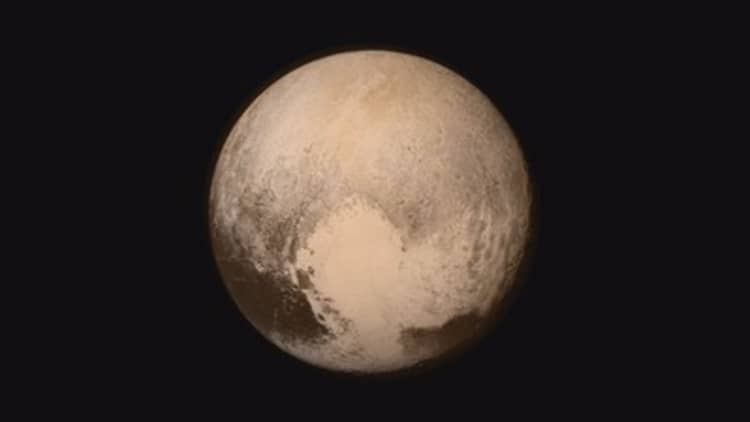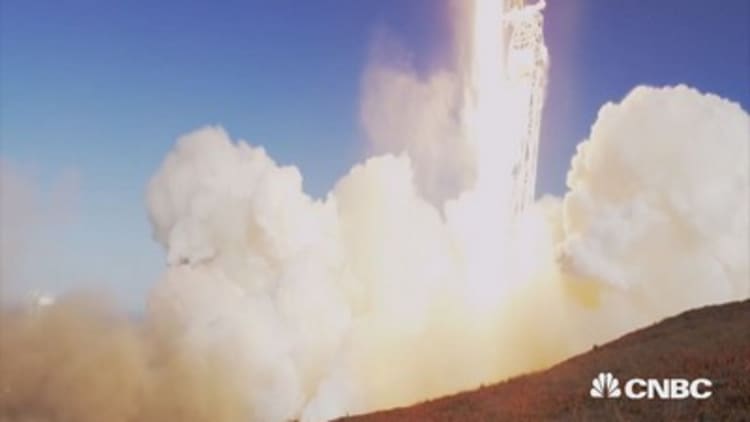
For a dwarf planet, Pluto draws a big crowd.
Pluto seems to hold a peculiar sort of status with the U.S. public. People took a record-setting interest in the recent space mission that brought the first close-up images of Pluto back to Earth, according to social media data from NASA. A quick Google Image search on the word "Pluto" now pulls up many more images of the planet than the Disney character of the same name, as the frozen planet gains prominence online. And a recent decision by astronomers to "demote" Pluto from planet status caused a minor uproar.
So what is it about Pluto that strikes a chord?
Astronomer Mike Brown, who has been studying Pluto and bodies like it for much of his career, thinks it has to do with the fact that Pluto is a mystery—a little-understood object at the farthest edge of our solar system.
Read MoreSpace photos: First images from our solar system
"I think the reason that the reason everyone got interested in the whole story about Pluto when it was reclassified is that there has always been this fascination with this kind of misfit underdog at the edge of the solar system that doesn't quite fit in," Brown told CNBC. "I remember as a kid, I loved Pluto. I didn't know what it was, but I thought it was the coolest planet out there."
So little is known about Pluto that it was not until 2006, almost 80 years after scientists first identified it, that astronomers decided at the International Astronomers Union in Prague that it should no longer be called a planet. That meant that the picture of the solar system that everyone around the world had learned in school was no longer accurate. There were no longer nine planets—there were eight.
Brown is the astronomer who first spotted Eris—the "dwarf planet" whose discovery tipped astronomers against considering Pluto as a true planet. The decision to downgrade Pluto to dwarf was highly controversial at the time, and even attracted criticism from Alan Stern, the lead scientist on the New Horizons mission, who called the choice "flawed."
There is nothing commercially viable that will help anybody on Earth by studying Pluto, and yet we do it anyway. We do it because as a species we explore the world around us.Mike Brownprofessor, California Institute of Technology
But both Brown and Jim Green, director of NASA's planetary sciences division, said that there's more about Pluto that's interesting, beyond its reclassification.
"We didn't really starting seeing objects beyond Pluto until the '90s," Green said. "So there is a whole new generation of people growing up in America that are starting to learn about a new population of objects beyond Neptune that are called Kuiper Belt objects. We know about maybe 2,000 of them, but there are probably tens of thousands of objects like them out there. Now, that is pretty spectacular."
Read MoreElon Musk: Here's what caused the SpaceX launch failure
Brown said these objects can also tell us more about how the solar system formed than the planets.
"I love these places," Brown said. "These are what I spend most of my time studying, and these places are where you get to figure out how the solar system put itself together. The planets are all so big and are so close to the sun, and their materials have been heated up and smashed and mixed around, and so you if look at the Earth and you get very little insight into how the Earth got here 4 1/2 billion years ago.
"But if you go into the outer part of the solar system, all of these objects have been essentially in deep freeze for 4.5 billion years, and you are getting a much closer direct look at what these things are like."

Surveys from Pew Research have shown Americans can be reluctant to fund the national space program, though they view it favorably. Brown said the interest reflects something deeply human.
"There is nothing commercially viable that will help anybody on Earth by studying Pluto, and yet we do it anyway. We do it because as a species we explore the world around us," he said. "This is exploration, pure and simple—exploration because that is what we do to be human. I am happy with that as a reason for why we do this."
Read MoreHow outer space is becoming the next Internet
The interest in the entire New Horizons mission was "far larger in the aggregate" on NASA.gov than other recent astronomical news, including the discovery, reported by NASA last week, of a planet that is similar to Earth, said NASA spokesperson Laurie Cantillo.
Data provided by the NASA.gov web team said that the Pluto flyby of the New Horizons spacecraft on July 14 generated the highest number of page views on NASA.gov since the agency began using Google Analytics in 2013. The site received 9.8 million page views on July 14, the day of the flyby.
Between July 13 and July 17, users (including NASA itself) on 21 different social media platforms created 1.7 million posts that used one or more of the keywords, "New Horizons," #PlutoFlyby or #Pluto, according to a report by NASA.


